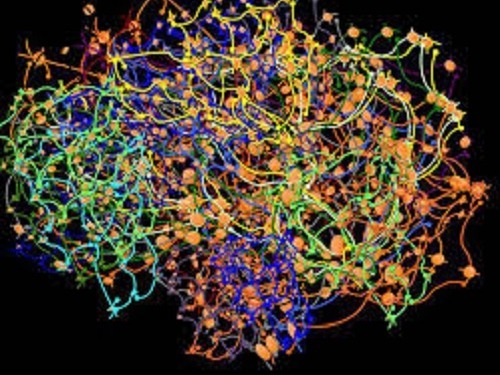Pain is clever. It learns. It is designed to protect us and is constantly analysing data to do so. Sometimes however it can do too good a job at protecting us and gives us unhelpful signals. So how does this happen and what do tomatoes have to do with it?
As a child you learned what the colour red was. This would have happened most likely by your parents telling you that something was red and then reinforcing that information any chance they got and testing you time and time again until you finally understood what red was. In doing so your brain developed a network of neurons and immune cells that represent the colour red. Every time you see something red this circuit gets switched on. These circuits are referred to as neurotags. They represent some form of information.
Over time you added to your knowledge of what red means. Red was associated with stop, danger, hot, the Chinese flag, communism maybe, apples, Ferrari and yes tomatoes. The list is endless. Each of those associations with red has it’s very own neurotag. For example a tomato has a neurotag but each type of tomato has it’s own specific neurotag. Cherry tomato, Roma, Better boy. All these neurotags communicate with each other and use overlapping information to come up with a conclusion. It’s pretty clever and that’s how we learn. In time these simple neurotags, for example red, grow more mass, that is more networks or circuits that they can connect with to give us the information we need.
Over a lifetime these networks become very complex. Red that is associated with tomato starts to become indirectly linked to salads, Mediterranean, Olive oil, pasta, pizza, Italy, Silvio Berlusconi!!
But of course not all tomatoes are red. When we think tomato we probably instantly picture a red one, unless you are a tomato grower and specialise in growing Lillian’s Yellow Heirloom tomatoes (I had to Google that), then maybe for you the word tomato is strongly associated with yellow and yellow means chicken and so on. Or perhaps to you tomatoes are Green. If you are Heston Blumenthal maybe tomatoes potentially mean ice cream and another Michelin star. The point is that the individual’s life will make connections depending on their own experiences and meaning for them and the simple colour red can mean many things to many people with complex associations that the brain is processing every time you see the colour red.
So how does this teach us about pain?

Pain works in the same way. It learns. It learns to connect all the bits of information available to it to come up with a conclusion and this evolves as time goes on. In the case of the red tomato the brain not only relies on the data it gets from the eyes such as the colour and shape of the tomato but it will also use perhaps smell and texture to decide if this is indeed a tomato and one that you want to eat. That’s all before you’ve even put it in your mouth and stimulated some of the taste sensors.
In the early stages of a pain experience the sensory data the body sends to the brain from a torn ankle ligament or suchlike is very helpful to warn us that something has happened and there is a potential threat to our well being. This is almost a reflex action. However that now starts the process of building a neurotag. The brain now has to start to collect information about this situation to protect us for the future and it will do so by for instance telling us that playing football is dangerous if we sprained our ankle in a game.
Of course we already have some knowledge that football could be dangerous and could sprain your ankle but until it happens to you it’s just potential. Now that it has happened it is real and the network of information in the brain will start to connect the dots. Your brain will recall stories it has heard about others who sprained their ankle or famous footballers and what impact it had on them or the experience of your sister or brother or neighbour who you lived next to 10 years ago. It’s all in there and the brain starts to develop and grow that neurotag. Everything that happens from then on will also play a part to a greater or lesser degree to establish what that neurotag will be affected by. For example the right or wrong advice on how to deal with that injury has a major impact.
How does the brain get this wrong sometime?

In the early stages the pain response is helpful. It’s designed to protect us and in very simple terms do no harm or seek help to get it sorted. After 3 months however (by which time most injuries have healed) the pain neurotag develops more influence and starts to give us a pain experience that is no longer acting as a way to protect us but in fact is over protecting us because it is being stimulated or influenced by complex indirectly related stimuli that are no longer relevant to tissue healing or well-being. As time goes on this becomes what is known as persistent pain and it is not a reliable indicator of tissue damage.
Pain is an output of the brain. In other words pain is what the brain tells us it is. This experience is formulated by sensory data coming in (how stuff looks, feels, moves etc), stored data (information we already have available to us) and predicted data (what we expect should happen when we join the dots). The brain then delivers a pain message to that body part.
As time goes on this pain experience can be influenced more by the stored data than the sensory data. For example if we believe that something is dangerous or harmful then we will have a pain experience even if that is no longer correct. Think of the footballer with the sprained ankle. Initially when the ankle was black and blue and swollen kicking a football would of course be painful and the brain would conclude don’t kick a football. That data was correct at the time. However as the tissues healed, swelling went down, range of movement returned, balance and power and all the other sensory data returned to normal the stored data kept saying “don’t kick a football” and the predicted data said “if you do you’ll damage something” then when you try to kick a ball it will probably hurt.
Just like an illusion the brain can make us see or feel things differently.
How can this be treated?

To treat persistent pain you have to re-calibrate the 3 influencing factors. Sensory data, stored data & predicted data.
You might need some physio to restore the sensory data to normal. For example range of movement, strength, power, co-ordination etc.
The stored data re-calibration is a combination of changing our thinking around obvious stuff that is no longer relevant but was at one stage and just seeing the association between these things can be a significant change in mindset. Also discovering the more obscure connections that have gained more influence on the pain neurotag than they should do. Seeing a tomato and thinking of Silvia Berlusconi for one!
The predicted data changes as the other two re-calibrate and then the re-learning gets reinforced just like we learned how to understand the colour red in the first place.
In summary, Pain is clever but not wise, it learns. It uses the knowledge available to it to come up with a conclusion and then you feel it. But there is a difference between knowledge and wisdom. Knowledge is knowing that a tomato is a fruit. Wisdom is knowing not to put it in a fruit salad.




0 Comments